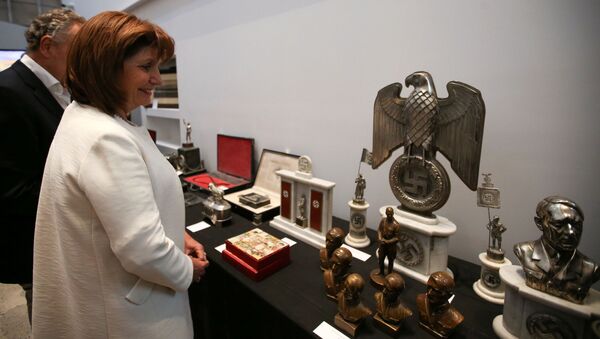Stephen Klingen, from Munich’s Central Institute for Art History, who was invited by Argentina to analyse a collection of 83 alleged Nazi artefacts, has raised doubts about the legitimacy of the articles, according to the Guardian on Friday.
Klingen concluded that the 83 objects are either complete fakes or original pieces from the 1930s which had swastikas and other Nazi symbols added at a later date.
The Guardian reported than Klingen said in an email that “You can display the objects as counterfeits, but you cannot learn anything about the Nazi era from them”.
Klingen also said he was shocked by the way the Argentinian authorities handled the objects and that he had issued a report to the chief of federal police, Néstor Roncaglia and security minister Patricia Bullrich last year stating unequivocally that the artefacts were almost certainly all forgeries.
He also attached to his 8-page report a 280-page addendum explaining how he reached his conclusions on a piece-by-piece basis.
The skull-measuring device was constructed between 1890 and 1910, according to the report, and therefore has no association with the Nazi period from 1933 - 1945.
The case of the device reads “Amt für Rassenpolitk” (“Office for Racial Politics”), but no official Nazi office functioned under that name, Klingen said.
Klingen explained that the handful of objects which may be genuine include: 3 toolboxes from a Mauser munitions factory, part of a grenade launcher, a swastika encrusted sundial, a Nazi-era newsreel, and various Hitler busts.
“Because we were not allowed to do material investigations, even their authenticity could not be checked conclusively”, he said.
When asked if the artefacts were of enough historical significance to warrant a display at a museum about the Holocaust, Klingen said: “No, absolutely not”.
Massive Nazi Artefact Stash Found in Secret Room in Argentina https://t.co/cDTCZSx7Bp pic.twitter.com/odan8Lj3OT
— VICE UK (@VICEUK) June 21, 2017
Despite Klingen's doubts, the Museo del Holocausto is planning to host the display of selected items on the basis that they may still have some educational value.
“They are original objects – original from the period – even if they were modified later”, said Jonathan Krszenbaum, the director of the museum.
“The skull-measuring instrument, even if the swastika was added later, is still from the Nazi period, or from the pre-Nazi period, and as such it has educational value because it exemplifies the Nazi obsession with the question of race.”
He added that “they are not forgeries – they are originals which were adulterated later. That doesn’t reduce their historical significance."
The collection of 83 items is ready to be placed on display next month, and includes a giant silver Nazi eagle, a Ouija board decorated with Nazi symbols, and a swastika-emblazoned device for skull measuring, and will be displayed in December once the museum reopens after undergoing a $4.5 million renovation.
“It’s been proven that they are real”, the president of the museum, Marcelo Mindlin, said at the press preview last month, adding that the artefacts were from "the time of the second world war".
Mindlin says that the items may have been brought to Argentina by fugitive Nazis, which would be consistent with stories of Nazi war criminals escaping to Argentina after the fall of the Third Reich, including Adolf Eichmann and Josef Mengele.
The objects were discovered behind a fake wall at the home of Buenos Aires antiquarian Carlos Olivares, who is currently awaiting trial for allegedly bribing customs officials in order to smuggle antiques from Asia and Africa into Argentina.




